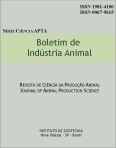Morphophysiological characteristcs and nutrition of aries grass (Panicum maximum, jacq.) with nitrogen fertilization
Keywords:
nitrogen nutrition, urea, urease inhibitorAbstract
Low availability of nitrogen (N) is a factor that limits forage production. Pastures are mostly formed of grasses, which need large N amounts to sustain high yields. Additionally, the availability of this nutrient affects the persistence and quality of the forage produced. However, when applying fertilizers containing nitrogen up to 50% can be lost, making their use costly for farmers. N is a highly volatile gas, and urea, widely used in agriculture, contains 46% N. When urea comes in contact with moisture in the soil, hydrolysis occurs due to the precipitation of the enzyme urease, accelerating the transformation of urea into ammonia, which can be lost by volatilization. One of the techniques to increase the efficiency of using urea is application of nitrogen fertilizers along with urease inhibitors, to retard the breakdown of urea so that it becomes incorporated in the soil slowly. One of the inhibitors used is N-(n-butyl) phosphate triamide (NBPT). This study aimed to assess the effect of nitrogen sources and doses on some productive characteristics of Ãries grass (Panicum maximum, Jacq) to find ways to improve the effectiveness of nitrogen application. The tests were performed at Centro Nutrição Animal e Pastagens €“ Instituto de Zootecnia in Nova Odessa, São Paulo, from March to August 2012. The experimental design was randomized blocks, with five replications in 2 x 3 factorial setup, where we studied the use of urea and urea containing urease inhibitor (NPBT), in pottery vessels (3.34 dm3). The treatments involved the following rates of N application: 0, 75.0 and 150.0 kg ha-1. The traits analyzed were dry biomass, leaf dry weight, dry weight of pseudostems, number of tillers, leaf area, nitrogen concentration and accumulation, and concentrations of chlorophyll and flavonoids. The data were analyzed using de GLM procedure of the SAS program. The results showed that nitrogen promoted considerable improvements in the plants, contributing to the production of biomass, number of tillers, chlorophyll content and nitrogen accumulation. However, no significant differences were found from the use of urea and urea containing urease inhibitor in the grass investigated in this study.Downloads
Downloads
Published
Issue
Section
License
Os autores não serão remunerados pela publicação de trabalhos, pois devem abrir mão de seus direitos autorais em favor deste periódico. Por outro lado, os autores ficam autorizados a publicar seus artigos, simultaneamente, em repositórios da instituição de sua origem, desde que citada a fonte da publicação original seja Boletim de Indústria Animal. A revista se reserva o direito de efetuar, nos originais, alterações de ordem normativa, ortográfica e gramatical, com vistas a manter o padrão culto da língua e a credibilidade do veículo. Respeitará, no entanto, o estilo de escrever dos autores. Alterações, correções ou sugestões de ordem conceitual serão encaminhadas aos autores, quando necessário. Nesses casos, os artigos, depois de adequados, deverão ser submetidos a nova apreciação. As opiniões emitidas pelos autores dos artigos são de sua exclusiva responsabilidade. Todo o conteúdo deste periódico, exceto onde está identificado, está licenciado sob a Licença Creative Commons Attribution (CC-BY-NC). A condição BY implica que os licenciados podem copiar, distribuir, exibir e executar a obra e fazer trabalhos derivados com base em que só se dão o autor ou licenciante os créditos na forma especificada por estes. A cláusula NC significa que os licenciados podem copiar, distribuir, exibir e executar a obra e fazer trabalhos derivados com base apenas para fins não comerciais.













